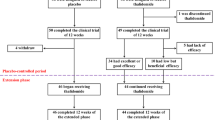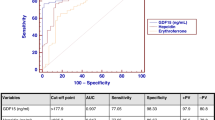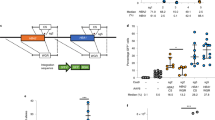Abstract
Individuals with β-thalassemia develop progressive systemic iron overload, resulting in high morbidity and mortality. These complications are caused by labile plasma iron, which is taken up by parenchymal cells in a dysregulated manner; in contrast, erythropoiesis depends on transferrin-bound iron uptake via the transferrin receptor. We hypothesized that the ineffective erythropoiesis and anemia observed in β-thalassemia might be ameliorated by increasing the amount of circulating transferrin. We tested the ability of transferrin injections to modulate iron metabolism and erythropoiesis in Hbbth1/th1 mice, an experimental model of β-thalassemia. Injected transferrin reversed or markedly improved the thalassemia phenotype in these mice. Specifically, transferrin injections normalized labile plasma iron concentrations, increased hepcidin expression, normalized red blood cell survival and increased hemoglobin production; this treatment concomitantly decreased reticulocytosis, erythropoietin abundance and splenomegaly. These results indicate that transferrin is a limiting factor contributing to anemia in these mice and suggest that transferrin therapy might be beneficial in human β-thalassemia.
This is a preview of subscription content, access via your institution
Access options
Subscribe to this journal
Receive 12 print issues and online access
$209.00 per year
only $17.42 per issue
Buy this article
- Purchase on Springer Link
- Instant access to full article PDF
Prices may be subject to local taxes which are calculated during checkout




Similar content being viewed by others
References
Weatherall, D.J. Pathophysiology of thalassaemia. Baillieres Clin. Haematol. 11, 127–146 (1998).
Pootrakul, P. et al. The effects of erythroid hyperplasia on iron balance. Blood 71, 1124–1129 (1988).
Centis, F. et al. The importance of erythroid expansion in determining the extent of apoptosis in erythroid precursors in patients with β-thalassemia major. Blood 96, 3624–3629 (2000).
Pippard, M.J., Callender, S.T., Warner, G.T. & Weatherall, D.J. Iron absorption and loading in β-thalassemia intermedia. Lancet 20, 819–821 (1979).
Park, C.H., Valore, E.V., Waring, A.J. & Ganz, T. Hepcidin, a urinary antimicrobial peptide synthesized in the liver. J. Biol. Chem. 276, 7806–7810 (2001).
Nemeth, E. et al. Hepcidin regulated cellular iron efflux by binding to ferroportin and inducing its internalization. Science 306, 2090–2093 (2004).
Papanikolaou, G. et al. Hepcidin in iron overload disorders. Blood 105, 4103–4105 (2005).
Adamsky, K. et al. Decreased hepdicin mRNA expression in thalassemic mice. Br. J. Haematol. 124, 123–124 (2004).
De Franceschi, L. et al. Liver expression of hepcidin and other iron genes in two mouse models of β-thalassemia. Haematologica 91, 1336–1342 (2006).
Gardenghi, S. et al. Ineffective erythropoiesis in β-thalassemia is characterized by increased iron absorption mediated by down-regulation of hepcidin and up-regulation of ferroportin. Blood 109, 5027–5035 (2007).
Finch, C. Regulators of iron balance in humans. Blood 84, 1697–1702 (1994).
Kattamis, A. et al. The effects of erythropoietic activity and iron burden on hepcidin expression in patients with thalassemia major. Haematologica 91, 809–812 (2006).
Vokurka, M., Krijt, J., Sulc, K. & Necas, E. Hepcidin mRNA levels in mouse liver respond to inhibition of erythropoiesis. Physiol. Res. 55, 667–674 (2006).
Esposito, B.P. et al. Labile plasma iron in iron overload: redox activity and susceptibility to chelation. Blood 102, 2670–2677 (2003).
Richardson, D.R. & Ponka, P. The molecular mechanisms of the metabolism and transport of iron in normal and neoplastic cells. Biochim. Biophys. Acta 1331, 1–40 (1997).
van Renswoude, J., Bridges, K.R., Harford, J.B. & Klausner, R.D. Receptor-mediated endocytosis of transferrin and the uptake of Fe in K562 cells: identification of a nonlysosomal acidic compartment. Proc. Natl. Acad. Sci. USA 79, 6186–6190 (1982).
Huebers, H.A. & Finch, C.A. The physiology of transferrin and transferrin receptors. Physiol. Rev. 67, 520–582 (1987).
Ginzburg, Y.Z. et al. Exogenous iron increases hemoglobin in β-thalassemic mice. Exp. Hematol. 37, 172–183 (2009).
Skow, L.C. et al. A mouse model for β-thalassemia. Cell 34, 1043–1052 (1983).
Chaudhury, C. et al. Accelerated transferrin degradation in HFE-deficient mice is associated with increased transferrin saturation. J. Nutr. 136, 2993–2998 (2006).
Raja, K.B., Pourtney, D.J., Simpson, R.J. & Peters, T.J. Importance of anemia and transferrin levels in the regulation of intestinal iron absorption in hypotransferrinemic mice. Blood 94, 3185–3192 (1999).
Chen, J.J. Regulation of protein synthesis by the heme-regulated eIF2alpha kinase: relevance to anemias. Blood 109, 2693–2699 (2007).
de Jong, K. et al. Short survival of phosphatidylserine-exposing red blood cells in murine sickle cell anemia. Blood 98, 1577–1584 (2001).
Beauchemin, H., Blouin, M.J. & Trudel, M. Differential regulatory and compensatory responses in hematopoiesis/erythropoiesis in α- and β-globin hemizygous mice. J. Biol. Chem. 279, 19471–19480 (2004).
Sorensen, S., Rubin, E., Polster, H., Mohandas, N. & Schrier, S. The role of membrane skeletal-associated α-globin in the pathophysiology of β-thalassemia. Blood 75, 1333–1336 (1990).
Kean, L.S. et al. Comparison of mechanisms of anemia in mice with sickle cell disease and β-thalassemia: peripheral destruction, ineffective erythropoiesis and phospholipid scramblase–mediated phosphatidylserine exposure. Exp. Hematol. 30, 394–402 (2002).
Ciavatta, D.J., Ryan, T.M., Farmer, S.C. & Townes, T.M. Mouse model of human β zero thalassemia: targeted deletion of the mouse β maj- and β min-globin genes in embryonic stem cells. Proc. Natl. Acad. Sci. USA 92, 9259–9263 (1995).
Tanno, T. et al. High levels of GDF15 in thalassemia suppress expression of the iron regulatory protein hepcidin. Nat. Med. 13, 1096–1101 (2007).
Tanno, T. et al. Identification of TWSG1 as a second novel erythroid regulator of hepcidin expression in murine and human cells. Blood 114, 181–186 (2009).
Silva, A.M. & Hider, R.C. Influence of non-enzymatic post-translation modifications on the ability of human serum albumin to bind iron. Implications for non-transferrin-bound iron speciation. Biochim. Biophys. Acta 1794, 1449–1458 (2009).
Huebers, H.A., Josephson, B., Huebers, E., Csiba, E. & Finch, C.A. Occupancy of the iron binding sites of human transferrin. Proc. Natl. Acad. Sci. USA 81, 4326–4330 (1984).
Huebers, H.A., Csiba, E., Huebers, E. & Finch, C.A. Competitive advantage of diferric transferrin in delivering iron to reticulocytes. Proc. Natl. Acad. Sci. USA 80, 300–304 (1983).
Libani, I.V. et al. Decreased differentiation of erythroid cells exacerbates ineffective erythropoiesis in β-thalassemia. Blood 112, 875–885 (2008).
Hosain, F., Marsaglia, G. & Finch, C.A. Blood ferrokinetics in normal man. J. Clin. Invest. 46, 1–9 (1967).
Parkkinen, J. et al. Effect of repeated apotransferrin administrations on serum iron parameters in patients undergoing myeloablative conditioning and allogeneic stem cell transplantation. Br. J. Haematol. 135, 228–234 (2006).
Garrick, L.M. et al. Tissue iron deposition in untransfused β-thalassemic mice. Exp. Hematol. 17, 423–428 (1989).
Raja, K.B., Pourtney, D.J., Simpson, R.J. & Peters, T.J. Importance of anemia and transferrin levels in the regulation of intestinal iron absorption in hypotransferrinemic mice. Blood 94, 3185–3192 (1999).
von Bonsdorff, L. et al. Development of a pharmaceutical apotransferrin product for iron binding therapy. Biologicals 29, 27–37 (2001).
Pootrakul, P. et al. Labile plasma iron (LPI) as an indicator of chelatable plasma redox activity in iron overloaded β-thalassemia/HbE treated with oral chelator. Blood 104, 1504–1510 (2004).
Kong, Y. et al. Loss of α-hemoglobin–stabilizing protein impairs erythropoiesis and exacerbates β-thalassemia. J. Clin. Invest. 114, 1457–1466 (2004).
Morrison, T.B., Weis, J.J. & Wittwer, C.T. Quantification of low-copy transcripts by continuous SYBR Green I monitoring during amplification. Biotechniques 24, 954–958 (1998).
Pfaffl, M.W. A new mathematical model for relative quantification in real-time RT-PCR. Nucleic Acids Res. 29, e45 (2001).
Socolovsky, M. et al. Ineffective erythropoiesis in Stat5a−/−5b−/− mice due to decreased survival of early erythroblasts. Blood 98, 3261–3273 (2001).
Liu, Y. et al. Suppression of Fas-FasL coexpression by erythropoietin mediates erythroblast expansion during the erythropoietic stress response in vivo. Blood 108, 123–133 (2006).
Pinheiro, J.C. & Bates, D.M. Approximations to the log-likelihood function in the non-linear mixed effects model. J. Comput. Graph. Statist. 4, 12–35 (1995).
Acknowledgements
We extend special thanks to M. Knutson (University of Florida, Gainesville) for providing mouse antibodies to FPN-1, Jacobi Medical Center for sample analysis, T. Ganz, E. Nemeth and S. Rivella for stimulating discussions and R. Nagel and M. Narla for unparalleled guidance and support. This work was supported in part by contract grant sponsor US National Institutes of Health–National Heart, Lung, and Blood Institute number HL68962 and HL07556.
Author information
Authors and Affiliations
Contributions
H.L. collected and analyzed the data. A.C.R. analyzed and interpreted the data and revised the manuscript. S.M.S. provided the study material and technical support. L.v.B. provided the study material and logistical and technical support and revised the manuscript. W.B. provided experimental assistance. C.B.H. performed statistical analysis and revised the manuscript. Z.I.C. provided logistical support, interpreted the data and revised the manuscript. E.E.B. provided logistical support, interpreted the data and revised the manuscript. M.E.F. provided the study material and logistical support, interpreted the data and revised the manuscript. Y.Z.G. developed the idea and designed the experiments, collected, analyzed and interpreted the data and drafted and revised the manuscript.
Corresponding author
Ethics declarations
Competing interests
The authors declare no competing financial interests.
Supplementary information
Supplementary Text and Figures
Supplementary Figures 1–3, Supplementary Tables 1 and 2 and Supplementary Methods (PDF 344 kb)
Rights and permissions
About this article
Cite this article
Li, H., Rybicki, A., Suzuka, S. et al. Transferrin therapy ameliorates disease in β-thalassemic mice. Nat Med 16, 177–182 (2010). https://doi.org/10.1038/nm.2073
Received:
Accepted:
Published:
Issue Date:
DOI: https://doi.org/10.1038/nm.2073
This article is cited by
-
The mutual crosstalk between iron and erythropoiesis
International Journal of Hematology (2022)
-
Serum transferrin as a biomarker of hepatocyte nuclear factor 4 alpha activity and hepatocyte function in liver diseases
BMC Medicine (2021)
-
Pleckstrin-2 is essential for erythropoiesis in β-thalassemic mice, reducing apoptosis and enhancing enucleation
Communications Biology (2021)
-
Oxidative Stress in β-Thalassemia
Molecular Diagnosis & Therapy (2019)
-
β-Thalassemia intermedia: a comprehensive overview and novel approaches
International Journal of Hematology (2018)



